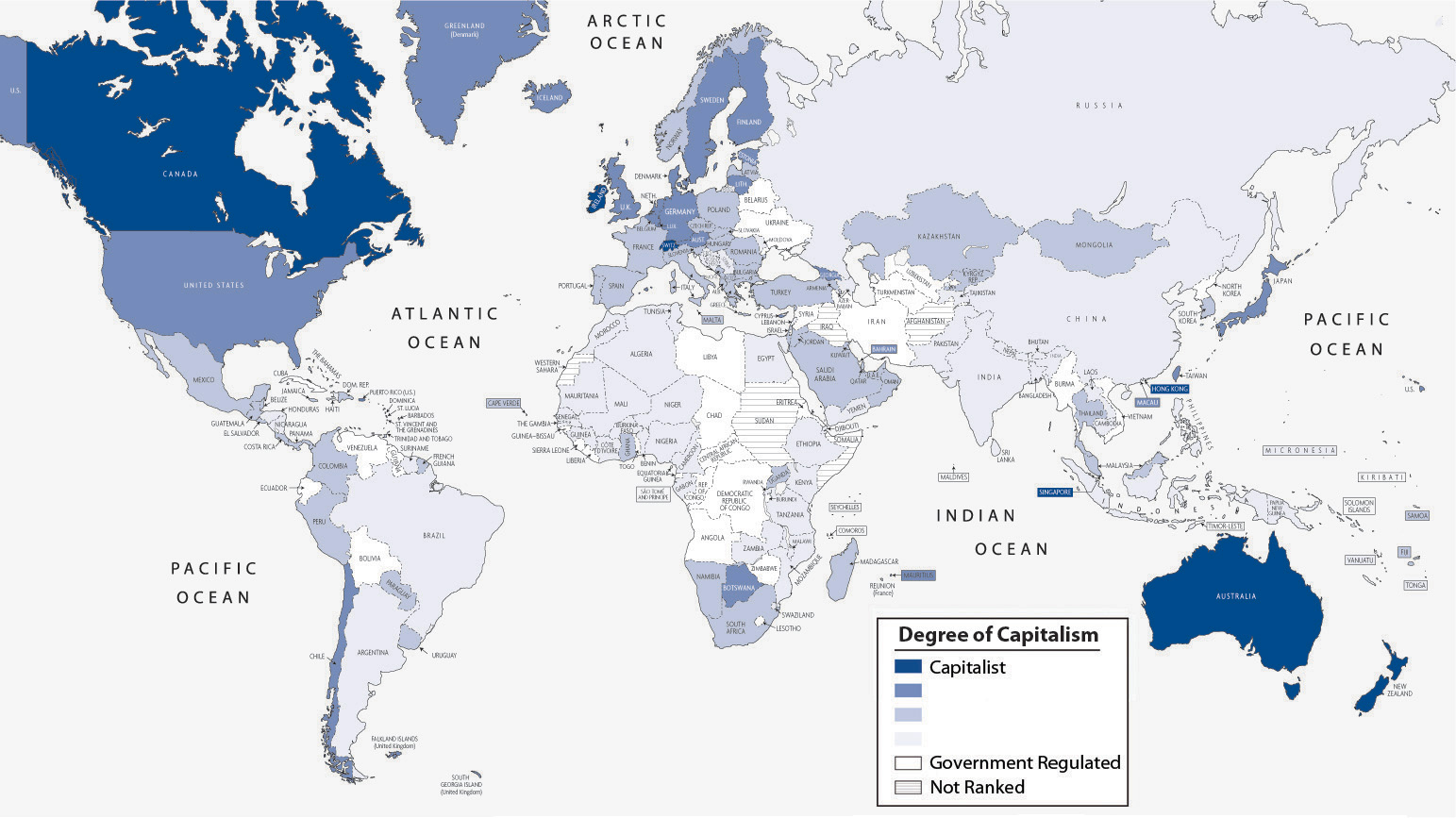Types of Economic Systems
Learning Objectives
- Distinguish the types of economic systems.
- Discuss the advantages and disadvantages of capitalism and socialism.
- Outline the elements of democratic socialism.
The two major economic systems in modern societies are capitalism and socialism. In practice, no one society is purely capitalist or socialist, so it is helpful to think of capitalism and socialism as lying on opposite ends of a continuum. Societies’ economies mix elements of both capitalism and socialism but do so in varying degrees, so that some societies lean toward the capitalist end of the continuum, while other societies lean toward the socialist end. For example, the United States is a capitalist nation, but the government still regulates many industries to varying degrees. The industries usually would prefer less regulation, while their critics usually prefer more regulation. The degree of such regulation was the point of controversy after the failure of banks and other financial institutions in 2008 and 2009 and after the BP oil spill in 2010. Let’s see how capitalism and socialism differ.
Capitalism
Scholars don’t always agree on a single definition of capitalism. For our purposes, we will define Capitalism is an economic system in which there is private ownership (as opposed to state ownership) and where there is an impetus to produce profit, and thereby wealth. By means of production, we mean everything—land, tools, technology, and so forth—that is needed to produce goods and services. As outlined by famed Scottish philosopher Adam Smith (1723–1790), widely considered the founder of modern economics, the most important goal of capitalism is the pursuit of personal profit (Smith, 1776/1910).
This is the type of economy in place in the United States today. Under capitalism, people invest capital (money or property invested in a business venture) in a business to produce a product or service that can be sold in a market to consumers. The investors in the company are generally entitled to a share of any profit made on sales after the costs of production and distribution are taken out. These investors often reinvest their profits to improve and expand the business or acquire new ones.
One important hallmark of capitalism is competition for profit. This competition is thought to help ensure the best products at the lowest prices, as companies will ordinarily try to keep their prices as low as possible to attract buyers and maximize their sales.
Consumerist Dot Com – sale window – CC BY 2.0.
As people pursue personal profit under capitalism, they compete with each other for the greatest profits. Businesses try to attract more demand for their products in many ways, including lowering prices, creating better products, and advertising how wonderful their products are. In capitalist theory, such competition helps ensure the best products at the lowest prices, again benefiting society as a whole. Such competition also helps ensure that no single party controls an entire market. According to Smith, the competition that characterizes capitalism should be left to operate on its own, free of government intervention or control. For this reason, capitalism is often referred to as laissez-faire (French for “leave alone”) capitalism, and terms to describe capitalism include the free-enterprise system and the free market.
The hallmarks of capitalism, then, are private ownership of the means of production, the pursuit of profit, competition for profit, and the lack of government intervention in this competition.
Capitalism in Practice
As capitalists began to dominate the economies of many countries during the Industrial Revolution, the rapid growth of businesses and their tremendous profitability gave some owners the capital they needed to create enormous corporations that could monopolize an entire industry. Many companies controlled all aspects of the production cycle for their industry, from the raw materials, to the production, to the stores in which they were sold. These companies were able to use their wealth to buy out or stifle any competition.
In the United States, the predatory tactics used by these large monopolies caused the government to take action. Starting in the late 1800s, the government passed a series of laws that broke up monopolies and regulated how key industries—such as transportation, steel production, and oil and gas exploration and refining—could conduct business.
The United States is considered a capitalist country. However, the U.S. government has a great deal of influence on private companies through the laws it passes and the regulations enforced by government agencies. Through taxes, regulations on wages, guidelines to protect worker safety and the environment, plus financial rules for banks and investment firms, the government exerts a certain amount of control over how all companies do business. State and federal governments also own, operate, or control large parts of certain industries, such as the post office, schools, hospitals, highways and railroads, and many water, sewer, and power utilities. Debate over the extent to which the government should be involved in the economy remains an issue of contention today. Some criticize such involvements as socialism (a type of state-run economy), while others believe intervention is necessary to protect the rights of workers and the well-being of the general population.
Socialism
Socialism is an economic system in which there is government ownership (often referred to as “state run”) of goods and their production, with an impetus to share work and wealth equally among the members of a society. Under socialism, everything that people produce, including services, is considered a social product. Everyone who contributes to the production of a good or to providing a service is entitled to a share in any benefits that come from its sale or use. To make sure all members of society get their fair share, governments must be able to control property, production, and distribution.
The focus in socialism is on benefitting society, whereas capitalism seeks to benefit the individual. Socialists claim that a capitalistic economy leads to inequality, with unfair distribution of wealth and individuals who use their power at the expense of society. Socialism strives, ideally, to control the economy to avoid the problems inherent in capitalism.
Within socialism, there are diverging views on the extent to which the economy should be controlled. One extreme believes all but the most personal items are public property. Other socialists believe only essential services such as healthcare, education, and utilities (electrical power, telecommunications, and sewage) need direct control. Under this form of socialism, farms, small shops, and businesses can be privately owned but are subject to government regulation.
The other area on which socialists disagree is on what level society should exert its control. In communist countries like the former Soviet Union, China, Vietnam, and North Korea, the national government exerts control over the economy centrally. They had the power to tell all businesses what to produce, how much to produce, and what to charge for it. Other socialists believe control should be decentralized so it can be exerted by those most affected by the industries being controlled. An example of this would be a town collectively owning and managing the businesses on which its residents depend.
Because of challenges in their economies, several of these communist countries have moved from central planning to letting market forces help determine many production and pricing decisions. Market socialism describes a subtype of socialism that adopts certain traits of capitalism, like allowing limited private ownership or consulting market demands. This could involve situations like profits generated by a company going directly to the employees of the company or being used as public funds (Gregory and Stuart 2003). Many Eastern European and some South American countries have mixed economies. Key industries are nationalized and directly controlled by the government; however, most businesses are privately owned and regulated by the government.
Organized socialism never became powerful in the United States. The success of labor unions and the government in securing workers’ rights, joined with the high standard of living enjoyed by most of the workforce, made socialism less appealing than the controlled capitalism practiced here. Figure 13.1 “Capitalism and Socialism Across the Globe” depicts the nations of the world along this continuum. Capitalist nations are found primarily in North America and Western Europe but also exist in other parts of the world.
Figure 13.1 Capitalism and Socialism Across the Globe
Source: Adapted from The Heritage Foundation. (2010). Distribution of economic freedom. Retrieved from http://www.heritage.org/index/pdf/2010/Index2010_map.pdf.
Socialism in Practice
As with capitalism, the basic ideas behind socialism go far back in history. Plato, in ancient Greece, suggested a republic in which people shared their material goods. Early Christian communities believed in common ownership, as did the systems of monasteries set up by various religious orders. Many of the leaders of the French Revolution called for the abolition of all private property, not just the estates of the aristocracy they had overthrown. Thomas More’s Utopia, published in 1516, imagined a society with little private property and mandatory labor on a communal farm. A utopia has since come to mean an imagined place or situation in which everything is perfect. Most experimental utopian communities had the abolition of private property as a founding principle.
Modern socialism really began as a reaction to the excesses of uncontrolled industrial capitalism in the 1800s and 1900s. The enormous wealth and lavish lifestyles enjoyed by owners contrasted sharply with the miserable conditions of the workers.
Some of the first great sociological thinkers studied the rise of socialism. Max Weber admired some aspects of socialism, especially its rationalism and how it could help social reform, but he worried that letting the government have complete control could result in an “iron cage of future bondage” from which there is no escape (Greisman and Ritzer 1981).
Pierre-Joseph Proudhon (1809−1865) was another early socialist who thought socialism could be used to create utopian communities. In his 1840 book, What Is Property?, he famously stated that “property is theft” (Proudhon 1840). By this he meant that if an owner did not work to produce or earn the property, then the owner was stealing it from those who did. Proudhon believed economies could work using a principle called mutualism, under which individuals and cooperative groups would exchange products with one another on the basis of mutually satisfactory contracts (Proudhon 1840).
By far the most important influential thinker on socialism is Karl Marx. Through his own writings and those with his collaborator, industrialist Friedrich Engels, Marx used a scientific analytical process to show that throughout history, the resolution of class struggles caused changes in economies. He saw the relationships evolving from slave and owner, to serf and lord, to journeyman and master, to worker and owner. Neither Marx nor Engels thought socialism could be used to set up small utopian communities. Rather, they believed a socialist society would be created after workers rebelled against capitalistic owners and seized the means of production. They felt industrial capitalism was a necessary step that raised the level of production in society to a point it could progress to a socialist and then communist state (Marx and Engels 1848). These ideas form the basis of the sociological perspective of social conflict theory.
Comparing Capitalism and Socialism
People have debated the relative merits of capitalism and socialism at least since the time of Marx (Bowles, 2007; Cohen, 2009). Compared to socialism, capitalism seems to have several advantages. It produces greater economic growth and productivity, at least in part because it provides more incentives (i.e., profit) for economic innovation. It also is often characterized by greater political freedom in the form of civil rights and liberties. As an economic system, capitalism seems to lend itself to personal freedom: because its hallmarks include the private ownership of the means of production and the individual pursuit of profit, there is much more emphasis in capitalist societies on the needs and desires of the individual and less emphasis on the need for government intervention in economic and social affairs.
Yet capitalism also has its drawbacks. There is much more economic inequality in capitalism than in socialism. Although capitalism produces economic growth, not all segments of capitalism share this growth equally, and there is a much greater difference between the rich and poor than under socialism. People can become very rich in capitalist nations, but they can also remain quite poor. As we saw in Chapter 9 “Global Stratification”, several Western European nations that are more socialist than the United States have fewer extremes of wealth and poverty and take better care of their poor.
Another possible drawback depends on whether you prefer competition or cooperation. As we saw in Chapter 3 “Culture”, important values in the United States include competition and individualism, both of which arguably reflect this nation’s capitalist system. Children in the United States are raised with more of an individual orientation than children in socialist societies, who learn that the needs of their society are more important than the needs of the individual. Whereas U.S. children learn to compete with each other for good grades, success in sports, and other goals, children in socialist societies learn to cooperate to achieve tasks.
More generally, capitalism is said by its critics to encourage selfish and even greedy behavior: if individuals try to maximize their profit, they do so at the expense of others. In competition, someone has to lose. A company’s ultimate aim, and one that is generally lauded, is to maximize its profits by driving another company out of the market altogether. If so, that company succeeds even if some other party is hurting. The small Mom-and-Pop grocery stores, drugstores, and hardware stores are almost a thing of the past, as big-box stores open their doors and drive their competition out of business. To its critics, then, capitalism encourages harmful behavior. Yet it is precisely this type of behavior that is taught in business schools.
Democratic Socialism
The economies of Denmark, pictured here, and several other Western European nations feature a combination of capitalism and socialism that is called democratic socialism. In these economies, the government owns important industries, but private property and political freedom remain widespread.
bobthemagicdragon – Majestic – CC BY-NC-ND 2.0.
Some nations combine elements of both capitalism and socialism and are called social democracies, while their combination of capitalism and socialism is called democratic socialism. In these nations, which include Denmark, Sweden, and several other Western European nations, the government owns several important industries, but much property remains in private hands, and political freedom is widespread. The government in these nations has extensive programs to help the poor and other people in need. Although these nations have high tax rates to help finance their social programs, their experience indicates it is very possible to combine the best features of capitalism and socialism while avoiding their faults (see the “Learning From Other Societies” box).
Key Takeaways
- The two major economic systems in modern societies are capitalism and socialism. In practice most societies have economies that mix elements of both systems but that lean toward one end of the capitalism–socialism continuum.
- Social democracies combine elements of both capitalism and socialism. They have achieved high economic growth while maintaining political freedom and personal liberty.
Self Check
Learning From Other Societies
Social Democracy in Scandinavia
The five Scandinavian nations, also called the Nordic nations, are Denmark, Finland, Iceland, Norway, and Sweden. These nations differ in many ways, but they also share many similarities. In particular, they are all social democracies, as their governments own important industries while their citizens enjoy much political freedom. Each nation has the three branches of government with which most people are familiar—executive, judicial, and legislative—and each nation has a national parliament to which people are elected by proportional representation.
Social democracies like the Scandinavian nations are often called controlled capitalist market economies. The word controlled here conveys the idea that their governments either own industries or heavily regulate industries they do not own. According to social scientist Tapio Lappi-Seppälä of Finland, a key feature of these social democracies’ economies is that inequality in wealth and income is not generally tolerated. Employers, employees, and political officials are accustomed to working closely to ensure that poverty and its related problems are addressed as much as possible and in as cooperative a manner as possible.
Underlying this so-called social welfare model is a commitment to universalism. All citizens, regardless of their socioeconomic status or family situation, receive various services, such as child care and universal health care, that are free or heavily subsidized. To support this massive provision of benefits, the Scandinavian nations have very high taxes that their citizens generally accept as normal and necessary.
This model has been praised by political scientist Torben Iversen, who lauds its goal of achieving full employment and equality. This attempt has not been entirely free of difficulties but overall has been very successful, as the Scandinavian nations rank at or near the top in international comparisons of health, education, economic well-being, and other measures of quality of life. The Scandinavian experience of social democracy teaches us that it is very possible to have a political and economic model that combines the best features of capitalism and socialism while retaining the political freedom that citizens expect in a democracy. (Berman, 2006; Iversen, 1998; Lappi-Seppälä, 2007)
References
Berman, S. (2006). The primacy of politics: Social democracy and the making of Europe’s twentieth century. New York, NY: Cambridge University Press.
Bowles, P. (2007). Capitalism. New York, NY: Pearson/Longman.
Cohen, G. A. (2009). Why not socialism? Princeton, NJ: Princeton University Press.
Iversen, T. (1998). The choices for Scandinavian social democracy in comparative perspective. Oxford Review of Economic Policy, 14, 59–75.
Lappi-Seppälä, T. (2007). Penal policy in Scandinavia. Crime and Justice, 36, 217–296.
Smith, A. (1910). The wealth of nations. London, England: J. M. Dent & Sons; New York, NY: E. P. Dutton. (Original work published 1776).




